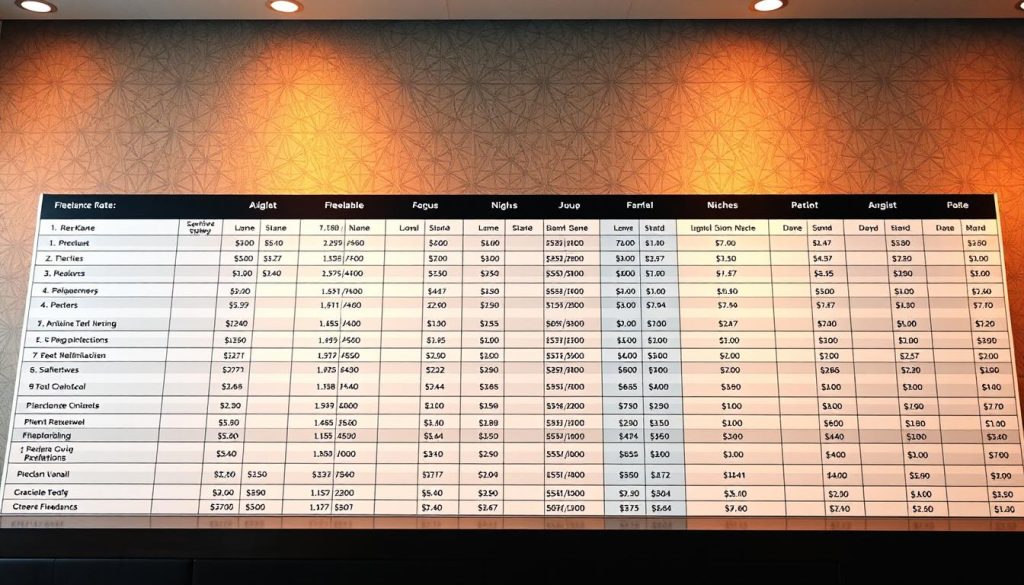Many editors and clients ask, “What’s your rate?” That question feels simple but hides a lot. Your price depends on scope, deliverable, and the value you bring — not a single universal number.
Feature journalism often uses per‑word bands, while corporate work can be billed by project or value. For context, some publications pay fixed per‑word amounts, and businesses sometimes offer higher project fees for short, high-impact copy.
Think of pricing as a system you can explain in plain language. Your number must cover the writing and the unpaid work behind the scenes so the business stays healthy. Per‑word can suit journalism; value-based fees often pay more for marketing outcomes.
We’ll walk through how to calculate a base rate, pick pricing models, see current benchmarks, scope projects, and negotiate with clients. If you ever feel unsure when asked for a number, a clear framework calms the mind and improves outcomes.
Table of Contents
Key Takeaways
- Set expectations: writing is a business; price by scope and value.
- Magazines often use per‑word bands; companies prefer project or retainer fees.
- Newer writers often start around $0.15–$0.25/word; niche and impact raise that range.
- Value-based and per‑project quotes can outperform time-based pricing.
- Always present quotes as clear offers with defined scope for both client and writer.
- For local guidance on daily and project pricing, consider resources like pricing calculators and benchmarks.
Start here: a friendly how-to on pricing your freelance work today
Cut the confusion: use a few clear steps to set a workable price fast.
Accept that pricing is a skill. Define your income needs, estimate billable time, pick a model, and match it to the project. This moves you from guessing to a repeatable process.
Many writers begin too low (think $0.04–$0.08/word) and draw weak offers. Aim at least $0.15–$0.20/word for new blog work and grow toward $0.50+ in niche areas.
« Ask, ‘What is your budget for this work?’ early — serious clients often give a number. »
- Give a range when specs are fuzzy; switch to a fixed rate once details are clear.
- Record time on a few projects to sharpen future quotes, even if you don’t bill hourly.
- Create a short services menu and use a 15‑minute discovery call to align on audience and goals.
| Step | What to do | Quick result |
|---|---|---|
| Define need | Set income goal and weekly availability | Targetable rate floor |
| Scope project | List deliverables, edits, and timeline | Cleaner quote |
| Ask budget | Politely request client range in first week | Faster alignment |
Action this week: pick one service, set a starter quote framework, and practice one budget question on a call. If scope or budget won’t support a professional rate, be ready to walk away — better clients are out there.
Set your base rate: calculate what you need to earn before you price anything
Begin with a concrete income target and work backward into a practical hourly floor.
Factor the true costs. List recurring expenses like taxes, healthcare, accounting, software, hosting, phone, and gear so your base covers the real cost of writing.
Include paid time off, holidays, and sick days. Full‑time business owners must cover weeks without billable work.
Estimate billable hours vs. total hours
Track a few weeks to see how marketing, proposals, and client emails cut into writing time. Most pros report you won’t hit 40 billable hours consistently.
Use a rate calculator to convert your annual income goal plus expenses into an hourly floor. Then translate that floor to per‑project or per‑word quotes.
| Level | Common band | Notes |
|---|---|---|
| Beginner | $0.15–$0.25/word | Content baseline |
| Corporate | $160–$300/hour | Higher scope & expectations |
| Specialist | Up to $750/hour | Elite niche work |
- Use your base as a floor to refuse offers that don’t cover your business needs.
- Adjust for experience, demand, and complexity when quoting clients.
- Revisit these numbers yearly as expenses and skill level change.
Choose the right pricing model for the job
Choose a pricing method that matches the work, the client, and the expected outcome. The model you pick shapes expectations, negotiation, and how you protect your time. Below are clear uses and practical ranges to help you decide.
Hourly rate: when it fits and common ranges
Use an hourly model when scope is undefined, stakeholders are many, or the client asks for flexible collaboration. It helps with revision‑heavy work and consulting by the hour.
Common ranges vary widely: from about $45/hour for smaller projects, up to $300/hour for corporate work, and as high as $750/hour for elite specialists.
Tip: Avoid hourly pricing if you’re fast. Your efficiency should not reduce your earning power.
Per‑word and per‑500‑word pricing
Per‑word works well for journalism and clear briefs. Typical bands run $0.15–$0.50+/word; magazines often pay $0.65–$1.00 or more.
Some writers sell per‑500‑word packages (for example, $150 per 500 words) to simplify admin and set expectations for recurring content.
Project and value‑based pricing
Charge for outcomes when conversion or impact matters. Value pricing lets you bill for the result, not just the hour.
For example, a short, high‑impact piece might earn nearly $400 for 250 words when it drives measurable business value. Anchor your fee with case studies and scope limits.
Monthly retainers
Retainers secure steady month‑to‑month income. Define deliverables, response times, and what’s out of scope.
Combine models: offer a retainer for ongoing blogs, project fees for launches, and hourly support for consulting.
| Model | Best when | Typical range |
|---|---|---|
| Hourly | Unclear scope, lots of revisions | $45–$750/hr |
| Per‑word / per‑500 | Clear briefs, editorial work | $0.15–$1.00+/word or $150/500w |
| Project / Value | Sales copy, landing pages | Outcome‑based; can exceed hourly math |
| Retainer | Ongoing content, predictable work | Monthly fee by deliverable |
« Communicate ranges first; switch to a fixed number once scope and timeline are locked. »
freelance rates by niche and deliverable: current market benchmarks
Market benchmarks show clear gaps between entry-level posts and high-value B2B work. Use these ranges to position offers for the right clients and scope.

Blog posts
Entry blog offers can fall as low as $25 per post or $0.04–$0.08/word. Aim for a floor of $0.15–$0.25/word and target $0.30–$0.50+/word as your portfolio and results improve.
Copywriting
Emails and landing pages sell outcomes, not time. Many writers charge $150–$1,000 per email. Landing pages and sales copy work best as fixed project fees tied to conversions.
Technical and B2B writing
Complex, data‑rich work commands higher fees. White papers often start near $2,000. Technical writers average about $81,470/year (~$39/hour), so adjust quotes for expertise and research time.
Magazines and publications
Feature pay commonly sits around $0.65–$1.00+/word, with some editors offering flat fees (for example, $200/article). One writer reported $0.50–$0.80/word last year for features.
- Set blog post expectations: floor, target, and portfolio goals.
- Anchor copywriting on outcomes and case studies.
- Price technical work for research time and client value.
- Use a client’s brand stage and funnel stakes to justify tiered offers.
| Deliverable | Typical range | Why it pays |
|---|---|---|
| Blog post (500w) | $75–$250 or $0.15–$0.50+/word | Volume + SEO value |
| $150–$1,000 | Direct revenue potential | |
| White paper | $2,000–$6,000+ | Lead generation & authority |
| Feature article | $0.65–$1.00+/word or $200+ | Editorial prestige |
| Corporate project | $160–$300/hour or project fee | Higher scope & approvals |
« Track outcomes—traffic, leads, conversions—to move from writing rates to value‑aligned fees. »
Scope before you quote: turn project needs into clear pricing
Start by translating client needs into a short, exact spec before you ever name a price. A crisp brief prevents guessing and keeps everyone aligned.
Build a spec sheet
Create a one‑page spec that lists research depth, interviews, SME access, number of revisions, SEO work, and any distribution extras. Example: 500‑word blog post + one interview + one round of edits + two social snippets + one headline.
Quote examples clients understand
Offer either a fixed example or a clear range. For instance: $400 for the example above, or $400–$600 depending on extra interviews or faster turnaround. If a client gives estimated hours, multiply by your rate and convert to a project fee they can approve.
Set payment terms
Request a deposit (commonly 50%), set milestone invoices, and include a kill fee if the work stops after you begin. State turnaround, feedback windows, and what counts as new scope.
« Ask for a budget early—people usually share a number when prompted. »
- List assumptions: stakeholders, source access, and review cycles.
- Price add‑ons clearly: extra interviews, design, or social posts.
- Summarize next steps so the client can approve fast.
| Spec item | Example | Price driver |
|---|---|---|
| Research depth | Light / Deep | Time & interviews |
| Interviews | 0–2 | Scheduling & transcription |
| Revisions | 1 round | Scope creep risk |
| Extras | 2 social snippets | Distribution value |
Negotiate with confidence: budgets, boundaries, and walking away
Start negotiations by making budget conversations simple and direct. A quick early question saves both time and awkward haggling.
Ask the budget early: simple scripts to get a number or range
Use a short opener: “To make sure I’m a fit and save us time, what budget did you set aside for this?”
If they hesitate, nudge with a clear bracket: “Even a range helps—more like a few hundred, a few thousand, or five figures?”

Handle pushback: anchor your value and know when to decline
When a client pushes back, calmly restate outcomes and scope. Say what the work includes and the time it takes.
« If the number won’t cover the professional time needed, it’s okay to decline and keep the door open. »
- Offer Tier A/B/C options so clients choose value over lowering the same scope.
- If an offer sits far below market, politely decline and suggest a future, better-scoped project.
For existing clients: when and how to raise rates respectfully
Give advance notice, cite results, and offer options to adjust scope to fit budgets. Use benchmarks and past outcomes to justify a new rate.
| Script | Quick outcome | Example prompt |
|---|---|---|
| Ask budget | Faster alignment | “What is your budget for this work?” |
| Range nudge | Ballpark revealed | “Are we talking €200, €2,000, or €200,000?” |
| Decline politely | Protect margin | “This offer won’t cover the scope; I can suggest alternatives.” |
Log wins and testimonials—experience makes future negotiation easier. For tips on growing offers and keeping client relationships healthy, see how to grow sustainably.
From newbie to pro: how freelancers grow rates over time
Moving up the pay ladder means packaging what you do so clients can buy outcomes, not hours.
Specialize, build a network, and package recurring work. Pick a niche where your experience matters. Specialized writers win higher fees faster because the stakes and value are clearer.
Productize monthly services—bundled blog posts, email sequences, or a retainer for updates. These create steady month‑to‑month income and shorten sales cycles.
Watch for signals you’re undercharging: a full pipeline, instant yeses, constant rush jobs, or projects that drain energy. These show demand, not value capture.
- Raise your freelance rate in small steps; test increases on new inquiries first.
- Shift from hourly rate to project or value pricing as you collect proof points.
- Offer tiered services so clients can scale up as trust grows.
« Use last year’s mix of hours, retainers, and one‑offs to set next year’s base and goals. »
Conclusion
Finish by turning principles into small weekly actions you can repeat.
Recap: set a clear base rate, choose the right pricing model, use market benchmarks, scope every project, and negotiate with calm confidence.
Try one change this week: ask for a budget early or price a blog post as a fixed project. Small experiments speed learning and protect your time.
Remember: professional writing fees should reflect the full work and the outcomes you deliver, not just the word count.
Review your menu and numbers each month or quarter so quotes stay aligned with demand. Iterate with each post and project — your pricing will get clearer and easier.
You are a skilled writer; the right clients will pay for results.
FAQ
What should I consider when I set a base hourly rate?
Start by calculating your target annual income, then add business expenses like taxes, health insurance, software, and marketing. Estimate billable hours realistically—include time for admin, pitches, and revisions—so your hourly floor covers both work and overhead. Use a calculator or spreadsheet to test different scenarios until the numbers balance.
How do I decide between hourly, per-word, or project pricing?
Match the model to the work. Hourly works for open-ended tasks or research. Per-word suits clear editorial work like blog posts. Project or value-based fees fit strategic tasks where outcomes matter, such as landing pages or campaign copy. Consider client preference, risk, and the predictability of the scope when choosing.
What are typical market bands for blog posts and copy?
Blog posts often fall into wide ranges—from budget briefs to well-researched pieces—so think in terms of
FAQ
What should I consider when I set a base hourly rate?
Start by calculating your target annual income, then add business expenses like taxes, health insurance, software, and marketing. Estimate billable hours realistically—include time for admin, pitches, and revisions—so your hourly floor covers both work and overhead. Use a calculator or spreadsheet to test different scenarios until the numbers balance.
How do I decide between hourly, per-word, or project pricing?
Match the model to the work. Hourly works for open-ended tasks or research. Per-word suits clear editorial work like blog posts. Project or value-based fees fit strategic tasks where outcomes matter, such as landing pages or campaign copy. Consider client preference, risk, and the predictability of the scope when choosing.
What are typical market bands for blog posts and copy?
Blog posts often fall into wide ranges—from budget briefs to well-researched pieces—so think in terms of $0.15–$0.50+ per word depending on depth. Sales copy, emails, and landing pages usually command higher fees because they directly affect revenue. Always price according to complexity and expected impact.
How do I account for taxes and benefits in my pricing?
Treat taxes and benefits as business costs. Add a percentage to your base rate to cover federal and state taxes, self-employment tax, and health insurance. Aim to set aside equivalent to an employer’s contributions so you don’t get surprised at tax time.
What’s a realistic estimate of billable hours per week?
Many experienced independent writers bill 15–25 hours a week. Expect less when you’re starting. Non-billable time—marketing, client management, and admin—can easily take 30–50% of your week, so build that into your rate calculations.
How do I build a spec sheet that helps scope projects accurately?
Outline goals, word counts, research needs, interviews, deliverables, rounds of edits, and any assets required. List milestones and deadlines. A clear spec sheet reduces scope creep and makes it easier to justify your fee to clients.
What payment terms should I use to protect my cash flow?
Common terms include a 25–50% deposit, net 15–30 for final payments, and milestone billing for larger projects. Include late fees, cancellation policies, and a “kill fee” if the client cancels after work has started. Clear terms avoid disputes and keep cash flowing.
How can I ask about a client’s budget without sounding awkward?
Be direct and helpful: “What budget have you set for this project?” or “Can you share a range so I can tailor options that fit?” Framing it as a way to propose useful solutions makes the question natural and professional.
When should I consider a retainer instead of individual project fees?
Choose retainers when clients need ongoing work or predictable monthly output. Retainers secure steady income and simplify planning. Define scope, deliverables, and rollover rules so both parties know what to expect each month.
How do I raise fees with existing clients without damaging the relationship?
Give advance notice, explain the reasons—added value, higher costs, new expertise—and offer a transition plan, like grandfathering old rates for a set period. Present the increase as part of a clear package of benefits, not just a price hike.
What signals show I’m undercharging for my services?
Red flags include constant overwork for limited pay, frequent rush jobs, clients pushing scope without higher fees, and full schedules with no ability to be selective. If demand outstrips your availability, it’s time to adjust pricing or streamline offerings.
How do niche and technical writing affect pricing?
Specialized areas like technical, medical, or B2B writing command higher fees because they require research, domain knowledge, and often interviews. Clients pay more for reduced risk and faster ramp-up, so highlight expertise when pitching in those niches.
Are there quick ways to present quotes that clients understand?
Offer tiered options: a basic package, a standard option, and a premium solution. Show what each includes, estimated timelines, and price ranges. This makes decisions easier and helps clients pick the level that matches their budget and goals.
.15–
FAQ
What should I consider when I set a base hourly rate?
Start by calculating your target annual income, then add business expenses like taxes, health insurance, software, and marketing. Estimate billable hours realistically—include time for admin, pitches, and revisions—so your hourly floor covers both work and overhead. Use a calculator or spreadsheet to test different scenarios until the numbers balance.
How do I decide between hourly, per-word, or project pricing?
Match the model to the work. Hourly works for open-ended tasks or research. Per-word suits clear editorial work like blog posts. Project or value-based fees fit strategic tasks where outcomes matter, such as landing pages or campaign copy. Consider client preference, risk, and the predictability of the scope when choosing.
What are typical market bands for blog posts and copy?
Blog posts often fall into wide ranges—from budget briefs to well-researched pieces—so think in terms of $0.15–$0.50+ per word depending on depth. Sales copy, emails, and landing pages usually command higher fees because they directly affect revenue. Always price according to complexity and expected impact.
How do I account for taxes and benefits in my pricing?
Treat taxes and benefits as business costs. Add a percentage to your base rate to cover federal and state taxes, self-employment tax, and health insurance. Aim to set aside equivalent to an employer’s contributions so you don’t get surprised at tax time.
What’s a realistic estimate of billable hours per week?
Many experienced independent writers bill 15–25 hours a week. Expect less when you’re starting. Non-billable time—marketing, client management, and admin—can easily take 30–50% of your week, so build that into your rate calculations.
How do I build a spec sheet that helps scope projects accurately?
Outline goals, word counts, research needs, interviews, deliverables, rounds of edits, and any assets required. List milestones and deadlines. A clear spec sheet reduces scope creep and makes it easier to justify your fee to clients.
What payment terms should I use to protect my cash flow?
Common terms include a 25–50% deposit, net 15–30 for final payments, and milestone billing for larger projects. Include late fees, cancellation policies, and a “kill fee” if the client cancels after work has started. Clear terms avoid disputes and keep cash flowing.
How can I ask about a client’s budget without sounding awkward?
Be direct and helpful: “What budget have you set for this project?” or “Can you share a range so I can tailor options that fit?” Framing it as a way to propose useful solutions makes the question natural and professional.
When should I consider a retainer instead of individual project fees?
Choose retainers when clients need ongoing work or predictable monthly output. Retainers secure steady income and simplify planning. Define scope, deliverables, and rollover rules so both parties know what to expect each month.
How do I raise fees with existing clients without damaging the relationship?
Give advance notice, explain the reasons—added value, higher costs, new expertise—and offer a transition plan, like grandfathering old rates for a set period. Present the increase as part of a clear package of benefits, not just a price hike.
What signals show I’m undercharging for my services?
Red flags include constant overwork for limited pay, frequent rush jobs, clients pushing scope without higher fees, and full schedules with no ability to be selective. If demand outstrips your availability, it’s time to adjust pricing or streamline offerings.
How do niche and technical writing affect pricing?
Specialized areas like technical, medical, or B2B writing command higher fees because they require research, domain knowledge, and often interviews. Clients pay more for reduced risk and faster ramp-up, so highlight expertise when pitching in those niches.
Are there quick ways to present quotes that clients understand?
Offer tiered options: a basic package, a standard option, and a premium solution. Show what each includes, estimated timelines, and price ranges. This makes decisions easier and helps clients pick the level that matches their budget and goals.
.50+ per word depending on depth. Sales copy, emails, and landing pages usually command higher fees because they directly affect revenue. Always price according to complexity and expected impact.
How do I account for taxes and benefits in my pricing?
Treat taxes and benefits as business costs. Add a percentage to your base rate to cover federal and state taxes, self-employment tax, and health insurance. Aim to set aside equivalent to an employer’s contributions so you don’t get surprised at tax time.
What’s a realistic estimate of billable hours per week?
Many experienced independent writers bill 15–25 hours a week. Expect less when you’re starting. Non-billable time—marketing, client management, and admin—can easily take 30–50% of your week, so build that into your rate calculations.
How do I build a spec sheet that helps scope projects accurately?
Outline goals, word counts, research needs, interviews, deliverables, rounds of edits, and any assets required. List milestones and deadlines. A clear spec sheet reduces scope creep and makes it easier to justify your fee to clients.
What payment terms should I use to protect my cash flow?
Common terms include a 25–50% deposit, net 15–30 for final payments, and milestone billing for larger projects. Include late fees, cancellation policies, and a “kill fee” if the client cancels after work has started. Clear terms avoid disputes and keep cash flowing.
How can I ask about a client’s budget without sounding awkward?
Be direct and helpful: “What budget have you set for this project?” or “Can you share a range so I can tailor options that fit?” Framing it as a way to propose useful solutions makes the question natural and professional.
When should I consider a retainer instead of individual project fees?
Choose retainers when clients need ongoing work or predictable monthly output. Retainers secure steady income and simplify planning. Define scope, deliverables, and rollover rules so both parties know what to expect each month.
How do I raise fees with existing clients without damaging the relationship?
Give advance notice, explain the reasons—added value, higher costs, new expertise—and offer a transition plan, like grandfathering old rates for a set period. Present the increase as part of a clear package of benefits, not just a price hike.
What signals show I’m undercharging for my services?
Red flags include constant overwork for limited pay, frequent rush jobs, clients pushing scope without higher fees, and full schedules with no ability to be selective. If demand outstrips your availability, it’s time to adjust pricing or streamline offerings.
How do niche and technical writing affect pricing?
Specialized areas like technical, medical, or B2B writing command higher fees because they require research, domain knowledge, and often interviews. Clients pay more for reduced risk and faster ramp-up, so highlight expertise when pitching in those niches.
Are there quick ways to present quotes that clients understand?
Offer tiered options: a basic package, a standard option, and a premium solution. Show what each includes, estimated timelines, and price ranges. This makes decisions easier and helps clients pick the level that matches their budget and goals.





